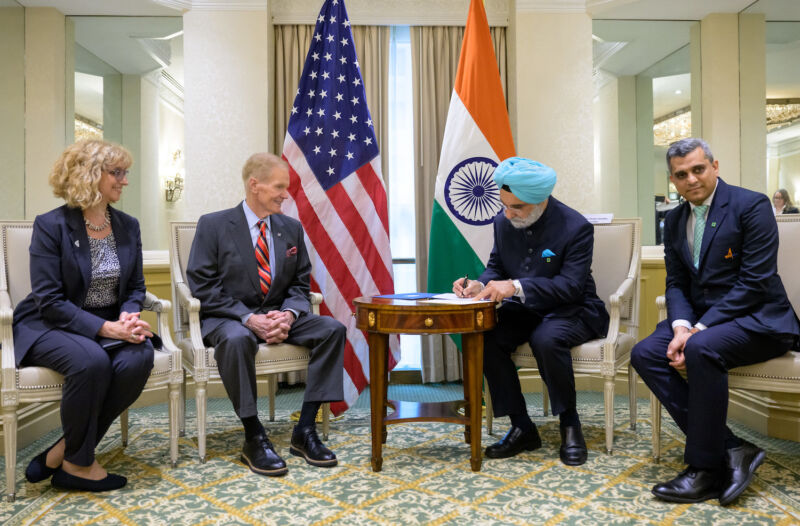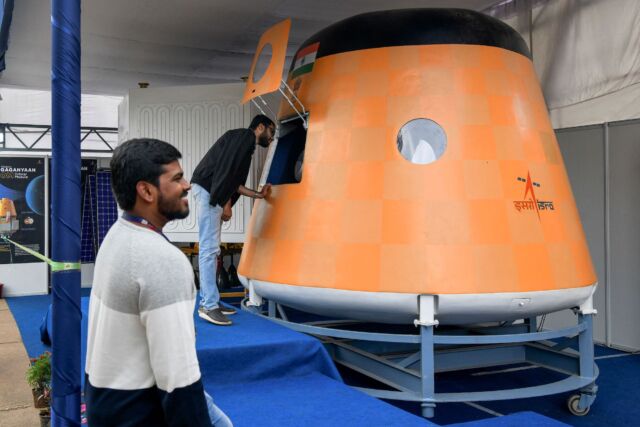
When India’s ambassador to the US signed up his country to the Artemis Accords last month, it signaled the world’s most populous country—with a growing prowess in spaceflight—could be turning toward the United States as a partner in space exploration.
India became the 27th country to sign the Artemis Accords, a non-binding set of principles among like-minded nations guiding a vision for peaceful and transparent exploration of space. The accords cover the international registration of human-made space objects, the open release of scientific data, and an agreement for nations not to claim territory on the Moon or other planetary bodies, among other tenets.
The Artemis Accords started under the Trump administration, an effort spearheaded by former NASA Administrator Jim Bridenstine and Mike Gold, an attorney and longtime space industry official. Bill Nelson, the NASA chief under President Biden, has embraced the accords. He said the principles are “just common sense.”
“You come to somebody’s aid in distress … You try to have commonality of parts, you respect each other’s territory,” Nelson said.
Details about future cooperation between the US and India remain scarce. Nelson plans to travel to India later this year for meetings and discussions with Indian space officials. One objective of Nelson’s trip will be to hammer out broad objectives for a “strategic framework” for human spaceflight cooperation.
Despite the name of the Artemis Accords, there’s no guarantee that India will play a significant role in NASA’s Artemis program to return astronauts to the Moon and eventually send humans to Mars.
“There’s no implication of a signatory to the Artemis accords also being part of the Artemis program,” Nelson told Ars.
But none of the other 26 signatories to the Artemis Accords—a list that includes European space powers and Japan—has their own human spaceflight program. India is developing a human-rated spacecraft called Gaganyaan that could be ready to fly people into low-Earth orbit in 2025, several years later than originally planned.

“The fact that they are a nation that intends in the future to fly own their own astronauts, is that significant? The answer is yes,” Nelson said. “I think it’s of significance that a major country that’s not considered aligned with the US (is) a signatory.”
“I’ve described India as a sleeping giant and one that is quickly awakening,” Gold told Ars. “India is absolutely vital to global space development, and Artemis in particular, since the country is active with lunar programs, Martian programs, and now even human spaceflight.”
Through the Artemis program, NASA hopes to land astronauts on the lunar surface later this decade for the first time since 1972. NASA officially targets the end of 2025 for the first Artemis crew landing on the Moon, but the schedule is almost certain to slip as new spacesuits from Axiom Space and a new human-rated lunar lander from SpaceX proceed through development and testing.
What’s next?
Where India might fit into the Artemis program is still to be determined. But India has launched as many space missions this year as Japan and Europe combined, with another milestone launch scheduled later this month with a robotic spacecraft that will mark India’s second attempt to achieve a controlled landing on the Moon, following a landing failure in 2019.
India successfully sent a spacecraft to Mars a decade ago, and international satellite operators regularly rely on Indian rockets to put their missions into orbit.
“They come to Artemis with activities that are already directly relevant to the program,” Gold said of India. “Neither the United States nor India needs to alter their trajectories at all. Their activities are already highly complementary.”
Before the Artemis Accords signing, the Indian Space Research Organizations—India’s space agency—and NASA were already working together on a sophisticated radar Earth observation satellite called NISAR scheduled for launch in 2024. An Indian satellite launched on the space shuttle in the 1980s.
But ISRO and NASA have not worked together in any significant way in the realm of human spaceflight or space exploration.








